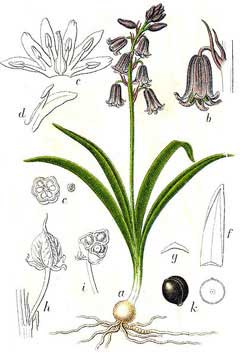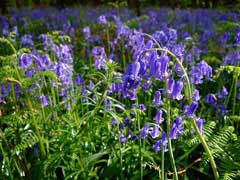 |
|
http://commons.wikimedia.org/wiki/File:Hyacinthoides_non-scripta_Sturm39.jpg |
 |
| http://commons.wikimedia.org/wiki/User:RX-Guru |
Translate this page:
Summary
Physical Characteristics

 Hyacinthoides nonscripta is a BULB growing to 0.3 m (1ft) by 0.2 m (0ft 8in).
Hyacinthoides nonscripta is a BULB growing to 0.3 m (1ft) by 0.2 m (0ft 8in).
See above for USDA hardiness. It is hardy to UK zone 5 and is not frost tender. It is in flower from May to June, and the seeds ripen from July to August. The species is hermaphrodite (has both male and female organs) and is pollinated by Flies, beetles.
Suitable for: light (sandy), medium (loamy) and heavy (clay) soils and can grow in heavy clay soil. Suitable pH: mildly acid, neutral and basic (mildly alkaline) soils. It can grow in semi-shade (light woodland) or no shade. It prefers dry or moist soil.
UK Hardiness Map
US Hardiness Map
Synonyms
Endymion non-scriptus. Scilla non-scriptus.
Plant Habitats
Woodland Garden Sunny Edge; Dappled Shade; Shady Edge;
Edible Uses
References More on Edible Uses
Medicinal Uses
Plants For A Future can not take any responsibility for any adverse effects from the use of plants. Always seek advice from a professional before using a plant medicinally.
Diuretic Styptic
The bulb has diuretic and styptic properties[4]. It is used as a remedy for leucorrhoea[4].
References More on Medicinal Uses
The Bookshop: Edible Plant Books
Our Latest books on Perennial Plants For Food Forests and Permaculture Gardens in paperback or digital formats.

Edible Tropical Plants
Food Forest Plants for Hotter Conditions: 250+ Plants For Tropical Food Forests & Permaculture Gardens.
More

Edible Temperate Plants
Plants for Your Food Forest: 500 Plants for Temperate Food Forests & Permaculture Gardens.
More

More Books
PFAF have eight books available in paperback and digital formats. Browse the shop for more information.
Shop Now
Other Uses
Adhesive Starch
A glue is obtained from the sap in the bulb and stem[4, 6, 66]. Simply cut open a bulb and apply the sap to whatever needs to be joined[K]. It makes an excellent paper glue, the join is stronger than the surrounding paper[6]. It would not work on non-absorbent materials such as plastics and glass[K]. A starch from the bulb has been used in laundering[4], it is very harsh on the skin[6].
Special Uses
Scented Plants
References More on Other Uses
Cultivation details
Easily grown in a soil rich in leafmold[90], preferring semi-shade[28, 31] but tolerating full sun. Succeeds in most soils but prefers a heavy one[200]. Succeeds in the dry shade of trees[188, 233]. Bulbs like to be quite deep in the soil[200]. The flowers diffuse a balsam-like scent in the sunshine[245].
References Carbon Farming Information and Carbon Sequestration Information
Temperature Converter
Type a value in the Celsius field to convert the value to Fahrenheit:
Fahrenheit:
The PFAF Bookshop
Plants For A Future have a number of books available in paperback and digital form. Book titles include Edible Plants, Edible Perennials, Edible Trees,Edible Shrubs, Woodland Gardening, and Temperate Food Forest Plants. Our new book is Food Forest Plants For Hotter Conditions (Tropical and Sub-Tropical).
Shop Now
Plant Propagation
Seed - sow early spring or as soon as ripe in a cold frame. It usually requires stratification. If you have plenty of seed it can be sown in situ, but it is usually more economical to sow it in a frame. If sown thinly, the seedlings can be left in their pots for the first year, though give them regular liquid feeds to make sure that they get sufficient nutrient. Prick out the seedlings about 3 to a pot and grow on for 1 - 2 more years before planting out into their permanent positions when they are dormant[K]. Division of the bulbs in summer after the leaves die down. Larger bulbs can be replanted direct into their permanent positions, but it is best to pot up smaller bulbs and grow them on for a year in a cold frame before planting them out when dormant in late summer.
Other Names
If available other names are mentioned here
Native Range
Coming Soon
Weed Potential
Right plant wrong place. We are currently updating this section.
Please note that a plant may be invasive in one area but may not in your area so it's worth checking.
Conservation Status
IUCN Red List of Threatened Plants Status :

Growth: S = slow M = medium F = fast. Soil: L = light (sandy) M = medium H = heavy (clay). pH: A = acid N = neutral B = basic (alkaline). Shade: F = full shade S = semi-shade N = no shade. Moisture: D = dry M = Moist We = wet Wa = water.
Now available:
Food Forest Plants for Mediterranean Conditions
350+ Perennial Plants For Mediterranean and Drier Food Forests and Permaculture Gardens.
[Paperback and eBook]
This is the third in Plants For A Future's series of plant guides for food forests tailored to
specific climate zones. Following volumes on temperate and tropical ecosystems, this book focuses
on species suited to Mediterranean conditions—regions with hot, dry summers and cool, wet winters,
often facing the added challenge of climate change.
Read More
Expert comment
Author
(L.)Chouard. ex Rothm.
Botanical References
17200
Links / References
For a list of references used on this page please go here
Readers comment